fescar的TXC模型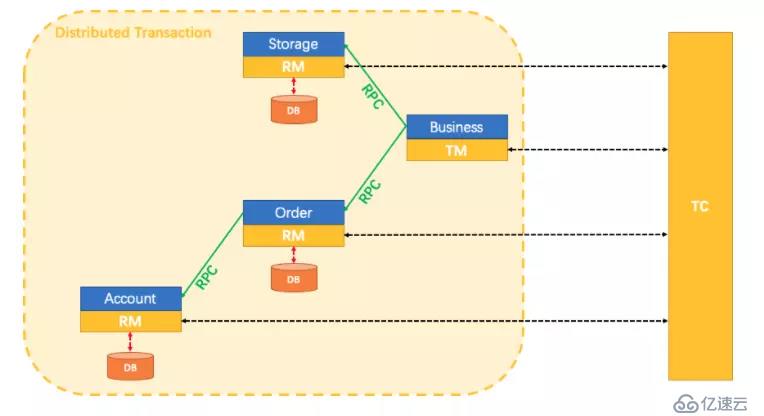
上图为fescar官方针对TXC模型制作的示意图。不得不说大厂的图制作的真的不错,结合示意图我们可以看到TXC实现的全貌。TXC的实现通过三个组件来完成。也就是上图的三个深×××部分,其作用如下,:
TM:全局事务管理器,在标注开启fescar分布式事务的服务端开启,并将全局事务发送到TC事务控制端管理
TC:事务控制中心,控制全局事务的提交或者回滚。这个组件需要独立部署维护,目前只支持单机版本,后续迭代计划会有集群版本
RM:资源管理器,主要负责分支事务的上报,本地事务的管理
一段话简述其实现过程:服务起始方发起全局事务并注册到TC。在调用协同服务时,协同服务的事务分支事务会先完成阶段一的事务提交或回滚,并生成事务回滚的undo_log日志,同时注册当前协同服务到TC并上报其事务状态,归并到同一个业务的全局事务中。此时若没有问题继续下一个协同服务的调用,期间任何协同服务的分支事务回滚,都会通知到TC,TC在通知全局事务包含的所有已完成一阶段提交的分支事务回滚。如果所有分支事务都正常,最后回到全局事务发起方时,也会通知到TC,TC在通知全局事务包含的所有分支删除回滚日志。在这个过程中为了解决写隔离和度隔离的问题会涉及到TC管理的全局锁。
本博文的目标是深入代码细节,探究其基本思路是如何实现的。首先会从项目的结构来简述每个模块的作用,继而结合官方自带的examples实例来探究整个分布式事务的实现过程。
项目结构解析
项目拉下来,用IDE打开后的目录结构如下,下面先大致的看下每个模块的实现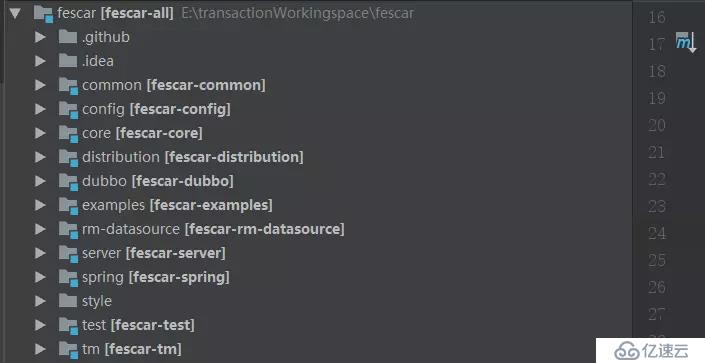
common :公共组件,提供常用辅助类,静态变量、扩展机制类加载器、以及定义全局的异常等
config : 配置加载解析模块,提供了配置的基础接口,目前只有文件配置实现,后续会有nacos等配置中心的实现
core : 核心模块主要封装了TM、RM和TC通讯用RPC相关内容
dubbo :dubbo模块主要适配dubbo通讯框架,使用dubbo的filter机制来传统全局事务的信息到分支
examples :简单的演示实例模块,等下从这个模块入手探索
rm-datasource :资源管理模块,比较核心的一个模块,个人认为这个模块命名为core要更合理一点。代理了JDBC的一些类,用来解析sql生成回滚日志、协调管理本地事务
server : TC组件所在,主要协调管理全局事务,负责全局事务的提交或者回滚,同时管理维护全局锁。
spring :和spring集成的模块,主要是aop逻辑,是整个分布式事务的入口,研究fescar的突破口
tm : 全局事务事务管理模块,管理全局事务的边界,全局事务开启回滚点都在这个模块控制
通过【examples】模块的实例看下效果
第一步、先启动TC也就是【Server】模块,main方法直接启动就好,默认服务端口8091
第二步、回到examples模块,将订单,业务,账户、仓库四个服务的配置文件配置好,主要是mysql数据源和zookeeper连接地址,这里要注意下,默认dubbo的zk注册中心依赖没有,启动的时候回抛找不到class的异常,需要添加如下的依赖:
<dependency>
<groupId>com.101tec</groupId>
<artifactId>zkclient</artifactId>
<version>0.10</version>
<exclusions>
<exclusion>
<artifactId>slf4j-log4j12</artifactId>
<groupId>org.slf4j</groupId>
</exclusion>
</exclusions>
</dependency>第三步、在BusinessServiceImpl中的模拟抛异常的地方打个断点,依次启动OrderServiceImpl、StorageServiceImpl、AccountServiceImpl、BusinessServiceImpl四个服务、等进断点后,查看数据库account_tbl表,金额已减去400元,变成了599元。然后放开断点、BusinessServiceImpl模块模拟的异常触发,全局事务回滚,account_tbl表的金额就又回滚到999元了
如上,我们已经体验到fescar事务的控制能力了,下面我们具体看下它是怎么控制的。
fescar事务过程分析
首先分析配置文件
这个是一个铁律,任何一个技术或框架要集成,配置文件肯定是一个突破口。从上面的例子我们了解到,实例模块的配置文件中配置了一个全局事务扫描器实例,如:
<bean class="com.alibaba.fescar.spring.annotation.GlobalTransactionScanner">
<constructor-arg value="dubbo-demo-app"/>
<constructor-arg value="my_test_tx_group"/>
</bean>这个实例在项目启动时会扫描所有实例,具体实现见【spring】模块。并将标注了@GlobalTransactional注解的方法织入GlobalTransactionalInterceptor的invoke方法逻辑。同时应用启动时,会初始化TM(TmRpcClient)和RM(RmRpcClient)的实例,这个时候,服务已经和TC事务控制中心勾搭上了。在往下看就涉及到TM模块的事务模板类TransactionalTemplate。
【TM】模块启动全局事务
全局事务的开启,提交、回滚都被封装在TransactionalTemplate中完成了,代码如:
public Object execute(TransactionalExecutor business) throws TransactionalExecutor.ExecutionException {
// 1. get or create a transaction
GlobalTransaction tx = GlobalTransactionContext.getCurrentOrCreate();
// 2. begin transaction
try {
tx.begin(business.timeout(), business.name());
} catch (TransactionException txe) {
throw new TransactionalExecutor.ExecutionException(tx, txe,
TransactionalExecutor.Code.BeginFailure);
}
Object rs = null;
try {
// Do Your Business
rs = business.execute();
} catch (Throwable ex) {
// 3. any business exception, rollback.
try {
tx.rollback();
// 3.1 Successfully rolled back
throw new TransactionalExecutor.ExecutionException(tx, TransactionalExecutor.Code.RollbackDone, ex);
} catch (TransactionException txe) {
// 3.2 Failed to rollback
throw new TransactionalExecutor.ExecutionException(tx, txe,
TransactionalExecutor.Code.RollbackFailure, ex);
}
}
// 4. everything is fine, commit.
try {
tx.commit();
} catch (TransactionException txe) {
// 4.1 Failed to commit
throw new TransactionalExecutor.ExecutionException(tx, txe,
TransactionalExecutor.Code.CommitFailure);
}
return rs;
}更详细的实现在【TM】模块中被分成了两个Class实现,如下:
DefaultGlobalTransaction :全局事务具体的开启,提交、回滚动作
DefaultTransactionManager :负责使用TmRpcClient向TC控制中心发送指令,如开启全局事务(GlobalBeginRequest)、提交(GlobalCommitRequest)、回滚(GlobalRollbackRequest)、查询状态(GlobalStatusRequest)等。
以上是TM模块核心内容点,TM模块完成全局事务开启后,接下来就开始看看全局事务iD,xid是如何传递、RM组件是如何介入的
【dubbo】全局事务xid的传递
首先是xid的传递,目前已经实现了dubbo框架实现的微服务架构下的传递,其他的像spring cloud和motan等的想要实现也很容易,通过一般RPC通讯框架都有的filter机制,将xid从全局事务的发起节点传递到服务协从节点,从节点接收到后绑定到当前线程上线文环境中,用于在分支事务执行sql时判断是否加入全局事务。fescar的实现见【dubbo】模块如下:
@Activate(group = { Constants.PROVIDER, Constants.CONSUMER }, order = 100)
public class TransactionPropagationFilter implements Filter {
private static final Logger LOGGER = LoggerFactory.getLogger(TransactionPropagationFilter.class);
@Override
public Result invoke(Invoker<?> invoker, Invocation invocation) throws RpcException {
String xid = RootContext.getXID();
String rpcXid = RpcContext.getContext().getAttachment(RootContext.KEY_XID);
if (LOGGER.isDebugEnabled()) {
LOGGER.debug("xid in RootContext[" + xid + "] xid in RpcContext[" + rpcXid + "]");
}
boolean bind = false;
if (xid != null) {
RpcContext.getContext().setAttachment(RootContext.KEY_XID, xid);
} else {
if (rpcXid != null) {
RootContext.bind(rpcXid);
bind = true;
if (LOGGER.isDebugEnabled()) {
LOGGER.debug("bind[" + rpcXid + "] to RootContext");
}
}
}
try {
return invoker.invoke(invocation);
} finally {
if (bind) {
String unbindXid = RootContext.unbind();
if (LOGGER.isDebugEnabled()) {
LOGGER.debug("unbind[" + unbindXid + "] from RootContext");
}
if (!rpcXid.equalsIgnoreCase(unbindXid)) {
LOGGER.warn("xid in change during RPC from " + rpcXid + " to " + unbindXid);
if (unbindXid != null) {
RootContext.bind(unbindXid);
LOGGER.warn("bind [" + unbindXid + "] back to RootContext");
}
}
}
}
}
}上面代码rpcXid不为空时,就加入到了RootContext的ContextCore中,这里稍微深入讲下。ContextCore是一个可扩展实现的接口,目前默认的实现是ThreadLocalContextCore,基于ThreadLocal来保存维护当前的xid。这里fescar提供了可扩展的机制,实现在【common】模块中,通过一个自定义的类加载器EnhancedServiceLoader加载需要扩展的服务类,这样只需要在扩展类加上@LoadLevel注解。标记order属性声明高优先级别,就可以达到扩展实现的目的。
【RM】模块本地资源管理的介入
fescar针对本地事务相关的接口,通过代理机制都实现了一遍代理类,如数据源(DataSourceProxy)、ConnectionProxy、StatementProxy等。这个在配置文件中也可以看出来,也就是说,我们要使用fescar分布式事务,一定要配置fescar提供的代理数据源。如: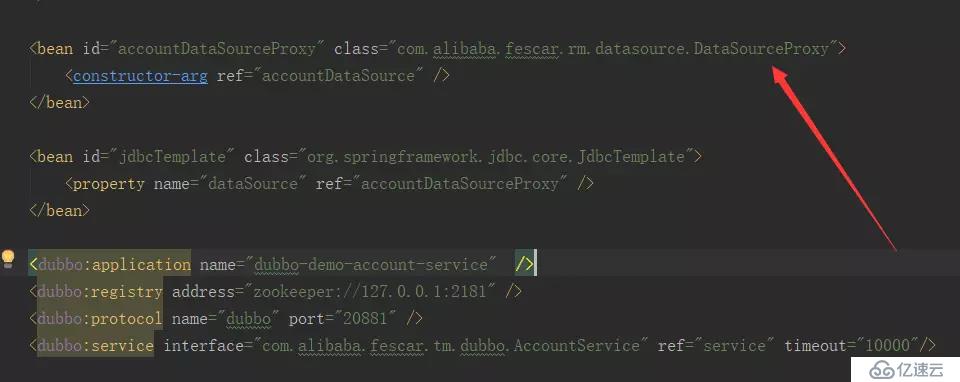
配置好代理数据源后,从DataSourceProxy出发,本地针对数据库的所有操作过程我们就可以随意控制了。从上面xid传递,已经知道了xid被保存在RootContext中了,那么请看下面的代码,就非常清楚了:
首先看StatementProxy的一段代码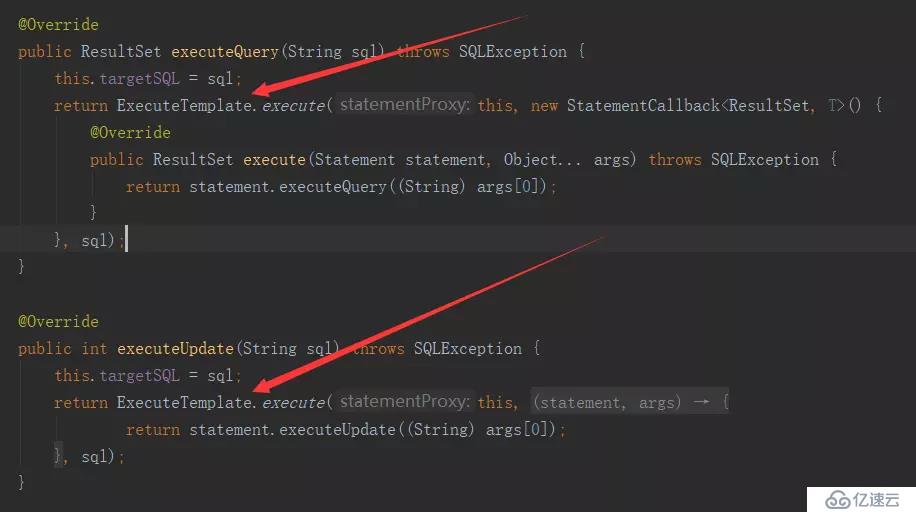
在看ExecuteTemplate中的代码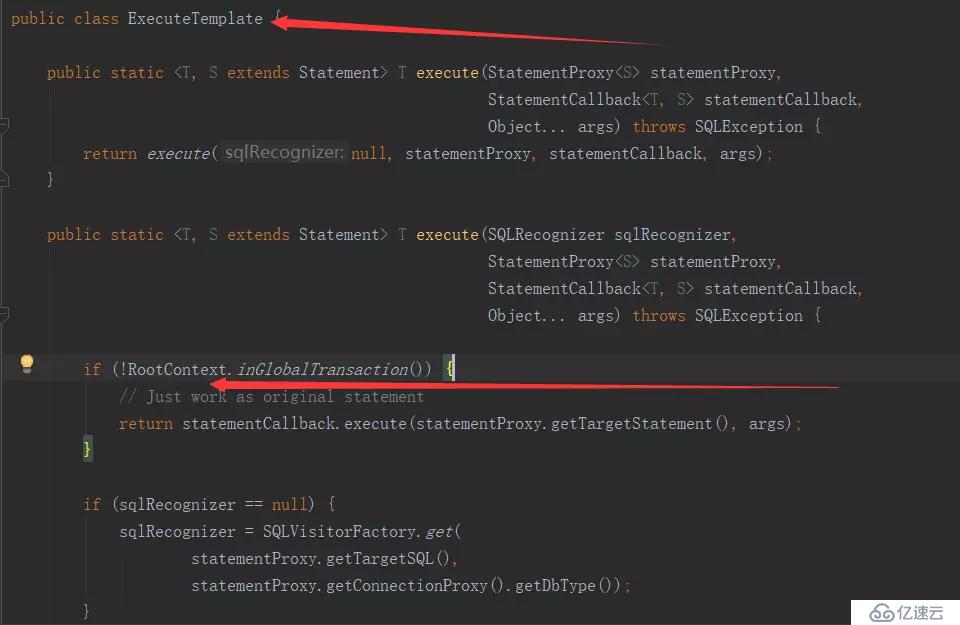
和【TM】模块中的事务管理模板类TransactionlTemplate类似,这里非常关键的逻辑代理也被封装在了ExecuteTemplate模板类中。因重写了Statement有了StatementProxy实现,在执行原JDBC的executeUpdate方法时,会调用到ExecuteTemplate的execute逻辑。在sql真正执行前,会判断RootCOntext当前上下文中是否包含xid,也就是判断当前是否是全局分布式事务。如果不是,就直接使用本地事务,如果是,这里RM就会增加一些分布式事务相关的逻辑了。这里根据sql的不同的类型,fescar封装了五个不同的执行器来处理,分别是UpdateExecutor、DeleteExecutor、InsertExecutor、SelectForUpdateExecutor、PlainExecutor,结构如下图: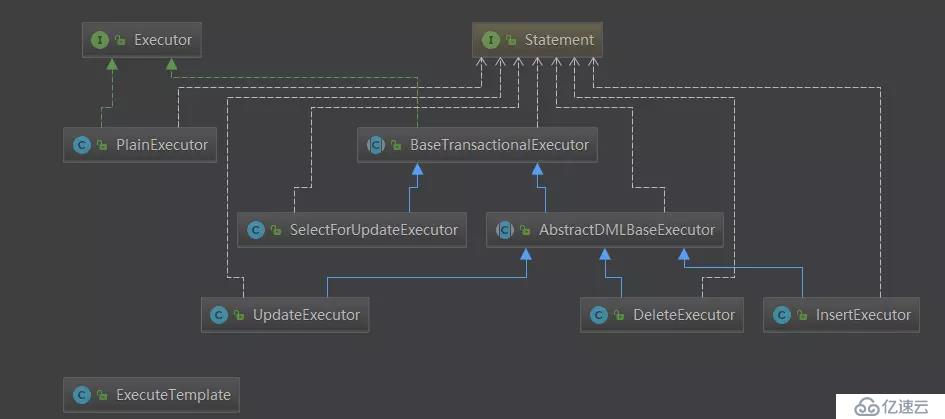
PlainExecutor:
原生的JDBC接口实现,未做任何处理,提供给全局事务中的普通的select查询使用
UpdateExecutor、DeleteExecutor、InsertExecutor:
三个DML增删改执行器实现,主要在sql执行的前后对sql语句进行了解析,实现了如下两个抽象接口方法:
protected abstract TableRecords beforeImage() throws SQLException;
protected abstract TableRecords afterImage(TableRecords beforeImage) throws SQLException;在这个过程中通过解析sql生成了提供回滚操作的undo_log日志,日志目前是保存在msyql中的,和业务sql操作共用同一个事务。表的结构如下: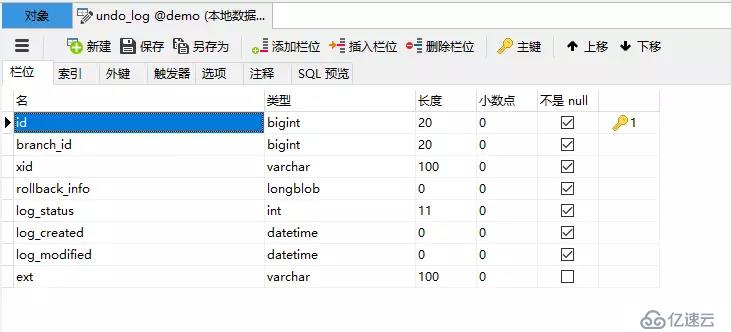
rollback_info保存的undo_log详细信息,是longblob类型的,结构如下:
{
"branchId":3958194,
"sqlUndoLogs":[
{
"afterImage":{
"rows":[
{
"fields":[
{
"keyType":"PrimaryKey",
"name":"ID",
"type":4,
"value":10
},
{
"keyType":"NULL",
"name":"COUNT",
"type":4,
"value":98
}
]
}
],
"tableName":"storage_tbl"
},
"beforeImage":{
"rows":[
{
"fields":[
{
"keyType":"PrimaryKey",
"name":"ID",
"type":4,
"value":10
},
{
"keyType":"NULL",
"name":"COUNT",
"type":4,
"value":100
}
]
}
],
"tableName":"storage_tbl"
},
"sqlType":"UPDATE",
"tableName":"storage_tbl"
}
],
"xid":"192.168.7.77:8091:3958193"
}
这里贴的是一个update的操作,undo_log记录的非常的详细,通过全局事务xid关联branchid,记录数据操作的表名,操作字段名,以及sql执行前后的记录数,如这个记录,表名=storage_tbl,sql执行前ID=10,count=100,sql执行后id=10,count=98。如果整个全局事务失败,需要回滚的时候就可以生成:
update storage_tbl set count = 100 where id = 10;这样的回滚sql语句执行了。
SelectForUpdateExecutor:
fescar的AT模式在本地事务之上默认支持读未提交的隔离级别,但是通过SelectForUpdateExecutor执行器,可以支持读已提交的隔离级别。代码如:
@Override
public Object doExecute(Object... args) throws Throwable {
SQLSelectRecognizer recognizer = (SQLSelectRecognizer) sqlRecognizer;
Connection conn = statementProxy.getConnection();
ResultSet rs = null;
Savepoint sp = null;
LockRetryController lockRetryController = new LockRetryController();
boolean originalAutoCommit = conn.getAutoCommit();
StringBuffer selectSQLAppender = new StringBuffer("SELECT ");
selectSQLAppender.append(getTableMeta().getPkName());
selectSQLAppender.append(" FROM " + getTableMeta().getTableName());
String whereCondition = null;
ArrayList<Object> paramAppender = new ArrayList<>();
if (statementProxy instanceof ParametersHolder) {
whereCondition = recognizer.getWhereCondition((ParametersHolder) statementProxy, paramAppender);
} else {
whereCondition = recognizer.getWhereCondition();
}
if (!StringUtils.isEmpty(whereCondition)) {
selectSQLAppender.append(" WHERE " + whereCondition);
}
selectSQLAppender.append(" FOR UPDATE");
String selectPKSQL = selectSQLAppender.toString();
try {
if (originalAutoCommit) {
conn.setAutoCommit(false);
}
sp = conn.setSavepoint();
rs = statementCallback.execute(statementProxy.getTargetStatement(), args);
while (true) {
// Try to get global lock of those rows selected
Statement stPK = null;
PreparedStatement pstPK = null;
ResultSet rsPK = null;
try {
if (paramAppender.isEmpty()) {
stPK = statementProxy.getConnection().createStatement();
rsPK = stPK.executeQuery(selectPKSQL);
} else {
pstPK = statementProxy.getConnection().prepareStatement(selectPKSQL);
for (int i = 0; i < paramAppender.size(); i++) {
pstPK.setObject(i + 1, paramAppender.get(i));
}
rsPK = pstPK.executeQuery();
}
TableRecords selectPKRows = TableRecords.buildRecords(getTableMeta(), rsPK);
statementProxy.getConnectionProxy().checkLock(selectPKRows);
break;
} catch (LockConflictException lce) {
conn.rollback(sp);
lockRetryController.sleep(lce);
} finally {
if (rsPK != null) {
rsPK.close();
}
if (stPK != null) {
stPK.close();
}
if (pstPK != null) {
pstPK.close();
}
}
}
} finally {
if (sp != null) {
conn.releaseSavepoint(sp);
}
if (originalAutoCommit) {
conn.setAutoCommit(true);
}
}
return rs;
}关键代码见:
TableRecords selectPKRows = TableRecords.buildRecords(getTableMeta(), rsPK);
statementProxy.getConnectionProxy().checkLock(selectPKRows);通过selectPKRows表操作记录拿到lockKeys,然后到TC控制器端查询是否被全局锁定了,如果被锁定了,就重新尝试,直到锁释放返回查询结果。
分支事务的注册和上报
在本地事务提交前,fescar会注册和上报分支事务相关的信息,见ConnectionProxy类的commit部分代码:
@Override
public void commit() throws SQLException {
if (context.inGlobalTransaction()) {
try {
register();
} catch (TransactionException e) {
recognizeLockKeyConflictException(e);
}
try {
if (context.hasUndoLog()) {
UndoLogManager.flushUndoLogs(this);
}
targetConnection.commit();
} catch (Throwable ex) {
report(false);
if (ex instanceof SQLException) {
throw (SQLException) ex;
} else {
throw new SQLException(ex);
}
}
report(true);
context.reset();
} else {
targetConnection.commit();
}
}从这段代码我们可以看到,首先是判断是了是否是全局事务,如果不是,就直接提交了,如果是,就先向TC控制器注册分支事务,为了写隔离,在TC端会涉及到全局锁的获取。然后保存了用于回滚操作的undo_log日志,继而真正提交本地事务,最后向TC控制器上报事务状态。此时,阶段一的本地事务已完成了。
【server】模块协调全局
关于server模块,我们可以聚焦在DefaultCoordinator这个类,这个是AbstractTCInboundHandler控制处理器默认实现。主要实现了全局事务开启,提交,回滚,状态查询,分支事务注册,上报,锁检查等接口,如: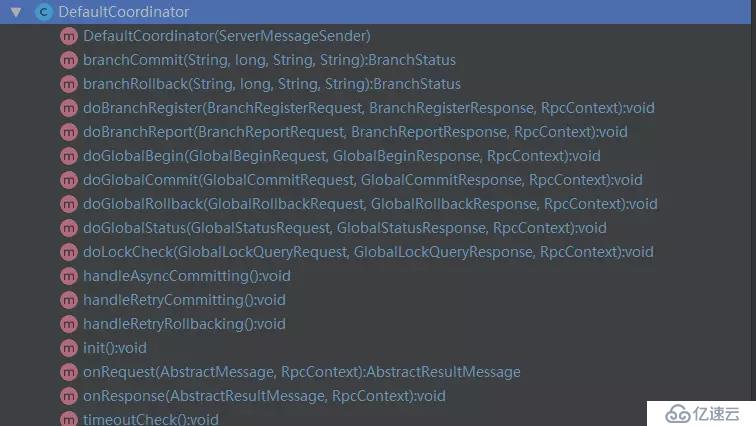
回到一开始的TransactionlTemplate,如果整个分布式事务失败需要回滚了,首先是TM向TC发起回滚的指令,然后TC接收到后,解析请求后会被路由到默认控制器类的doGlobalRollback方法内,最终在TC控制器端执行的代码如下:
@Override
public void doGlobalRollback(GlobalSession globalSession, boolean retrying) throws TransactionException {
for (BranchSession branchSession : globalSession.getReverseSortedBranches()) {
BranchStatus currentBranchStatus = branchSession.getStatus();
if (currentBranchStatus == BranchStatus.PhaseOne_Failed) {
continue;
}
try {
BranchStatus branchStatus = resourceManagerInbound.branchRollback(XID.generateXID(branchSession.getTransactionId()), branchSession.getBranchId(),
branchSession.getResourceId(), branchSession.getApplicationData());
switch (branchStatus) {
case PhaseTwo_Rollbacked:
globalSession.removeBranch(branchSession);
LOGGER.error("Successfully rolled back branch " + branchSession);
continue;
case PhaseTwo_RollbackFailed_Unretryable:
GlobalStatus currentStatus = globalSession.getStatus();
if (currentStatus.name().startsWith("Timeout")) {
globalSession.changeStatus(GlobalStatus.TimeoutRollbackFailed);
} else {
globalSession.changeStatus(GlobalStatus.RollbackFailed);
}
globalSession.end();
LOGGER.error("Failed to rollback global[" + globalSession.getTransactionId() + "] since branch[" + branchSession.getBranchId() + "] rollback failed");
return;
default:
LOGGER.info("Failed to rollback branch " + branchSession);
if (!retrying) {
queueToRetryRollback(globalSession);
}
return;
}
} catch (Exception ex) {
LOGGER.info("Exception rollbacking branch " + branchSession, ex);
if (!retrying) {
queueToRetryRollback(globalSession);
if (ex instanceof TransactionException) {
throw (TransactionException) ex;
} else {
throw new TransactionException(ex);
}
}
}
}
GlobalStatus currentStatus = globalSession.getStatus();
if (currentStatus.name().startsWith("Timeout")) {
globalSession.changeStatus(GlobalStatus.TimeoutRollbacked);
} else {
globalSession.changeStatus(GlobalStatus.Rollbacked);
}
globalSession.end();
}如上代码可以看到,回滚时从全局事务会话中迭代每个分支事务,然后通知每个分支事务回滚。分支服务接收到请求后,首先会被路由到RMHandlerAT中的doBranchRollback方法,继而调用了RM中的branchRollback方法,代码如下:
@Override
public BranchStatus branchRollback(String xid, long branchId, String resourceId, String applicationData) throws TransactionException {
DataSourceProxy dataSourceProxy = get(resourceId);
if (dataSourceProxy == null) {
throw new ShouldNeverHappenException();
}
try {
UndoLogManager.undo(dataSourceProxy, xid, branchId);
} catch (TransactionException te) {
if (te.getCode() == TransactionExceptionCode.BranchRollbackFailed_Unretriable) {
return BranchStatus.PhaseTwo_RollbackFailed_Unretryable;
} else {
return BranchStatus.PhaseTwo_RollbackFailed_Retryable;
}
}
return BranchStatus.PhaseTwo_Rollbacked;
}M分支事务端最后执行的是UndoLogManager的undo方法,通过xid和branchid从数据库查询出回滚日志,完成数据回滚操作,整个过程都是同步完成的。如果全局事务是成功的,TC也会有类似的上述协调过程,只不过是异步的将本次全局事务相关的undo_log清除了而已。至此,就完成了2阶段的提交或回滚,也就完成了完整的全局事务事务的控制。
结语
如果你看到这里,那么非常感谢你,在繁忙工作之余耐心的花时间来学习。同时,我相信花的时间没白费,完整的浏览理解估计对fescar实现的大致流程了解的十之八九了。本文从构思立题到完成大概耗时1人天左右,博主在这个过程中,对fescar的实现也有了更加深入的了解。由于篇幅原因,并没有面面俱到的对每个实现的细节去深究,如sql是如何解析的等,更多的是在fescar的TXC模型的实现过程的关键点做了详细阐述。本文已校对,但由于个人知识水平及精力有限,文中不免出现错误或理解不当的地方,欢迎指正。
感兴趣的可以自己来我的Java架构群,可以获取免费的学习资料,群号:855801563 对Java技术,架构技术感兴趣的同学,欢迎加群,一起学习,相互讨论。
亿速云「云服务器」,即开即用、新一代英特尔至强铂金CPU、三副本存储NVMe SSD云盘,价格低至29元/月。点击查看>>
免责声明:本站发布的内容(图片、视频和文字)以原创、转载和分享为主,文章观点不代表本网站立场,如果涉及侵权请联系站长邮箱:is@yisu.com进行举报,并提供相关证据,一经查实,将立刻删除涉嫌侵权内容。